“Arena”
Written by Fredric Brown and Gene L. Coon
Directed by Joseph Pevney
Season 1, Episodes 19
Production episode 6149-19
Original air date: January 19, 1967
Stardate: 3045.6
Captain’s log. Kirk, Spock, McCoy, and the Enterprise‘s best tactical specialists are beaming down to the base on Cestus III—an isolated colony, and one commanded by Commodore Travers. Kirk and McCoy are looking forward to seeing Travers’s chef as much as they are the commodore himself.
When they materialize on the surface, however, they find a smoking ruin where the base should be. Kirk immediately puts the Enterprise on red alert. The base was obviously destroyed days ago, so the messages they received from Travers were faked. Spock takes tricorder readings, while Kirk sends Lang and Kelowitz to search for survivors. O’Herlihy sticks with Kirk, Spock, and McCoy, and they find one survivor who’s got bad radiation burns and internal injuries. Spock also detects non-human life nearby. O’Herlihy investigates and is vaporized by some kind of disruptor mortar.
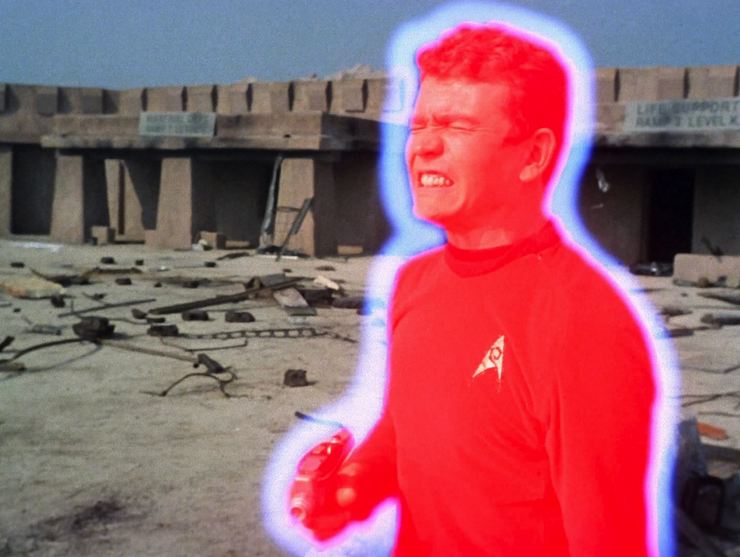
Even as the landing party comes under fire, so too does the Enterprise. Sulu has to defend the ship, so he can’t beam the party back. Kirk orders Sulu to not concern himself with the landing party until the ship is safe. Kirk, Spock, McCoy, Lang, and Kelowitz take cover in the ruins of the base, while in orbit Sulu engages the enemy ship, which has not identified itself, nor does it match any known configuration.
Sulu’s forced to leave orbit. Kirk goes to the armory and fetches a grenade launcher. Kelowitz gives Kirk a bearing as the most likely path they’d take (Lang at this point has also been killed). Kirk fires, and the shelling of the party stops. The enemy beam back to their ship and head out of orbit. Sulu’s able to beam the landing party up, now, and he does so, beaming down a medical team on Kirk’s order to search for more survivors.
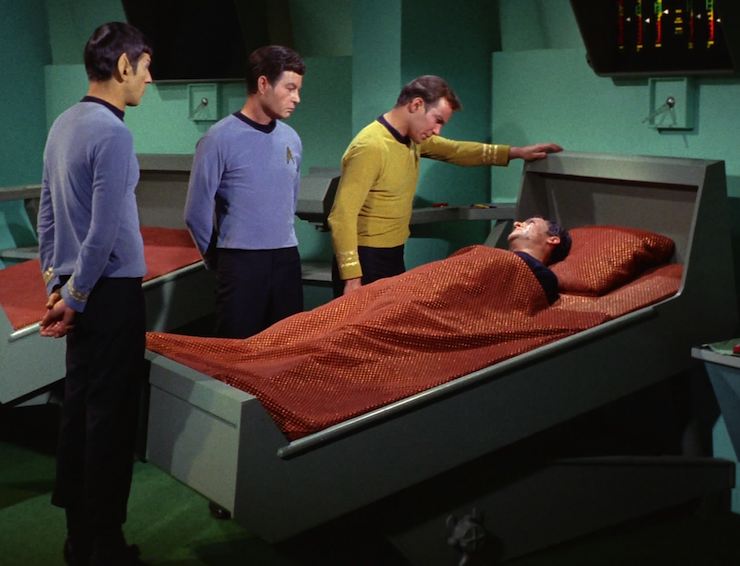
The Enterprise pursues the other ship. Kirk debriefs the survivor in sickbay. The aliens attacked with no warning, no communication, and then set a trap for the Enterprise, the only protection in the area. Kirk is convinced that this is a prelude to an invasion and so he orders Sulu to overtake the enemy vessel. They are entering an unexplored region of space.
Each time they increase speed to overtake the enemy ship, they increase speed as well. They go to warp seven, which is a speed they can’t maintain for long—and then warp eight, which is even more dangerous. But they start to close in as they near a solar system.
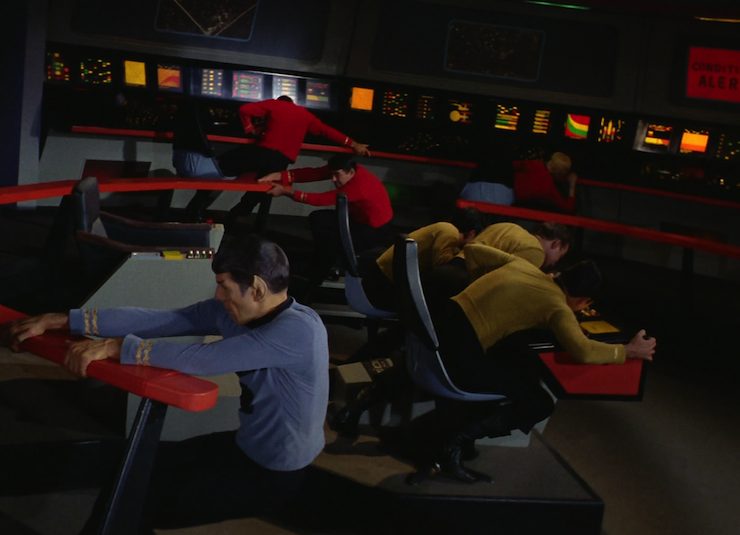
Uhura reports that someone in that solar system is scanning the Enterprise. Sulu then reports that the alien ship is slowing down to a dead stop—and then when the Enterprise moves in, they are also brought to a dead stop. All propulsion and weapons systems are inoperative—no damage, but no power, either. Life support is working fine, at least, and Spock reports that they’re being held in place by some unseen force.
They are then contacted by the Metrons, who communicate via a psychedelic light show on the viewscreen. They find the confrontation that was about to ensue to be violent and icky, and so they will resolve it in a manner most suited to their limited mentalities.
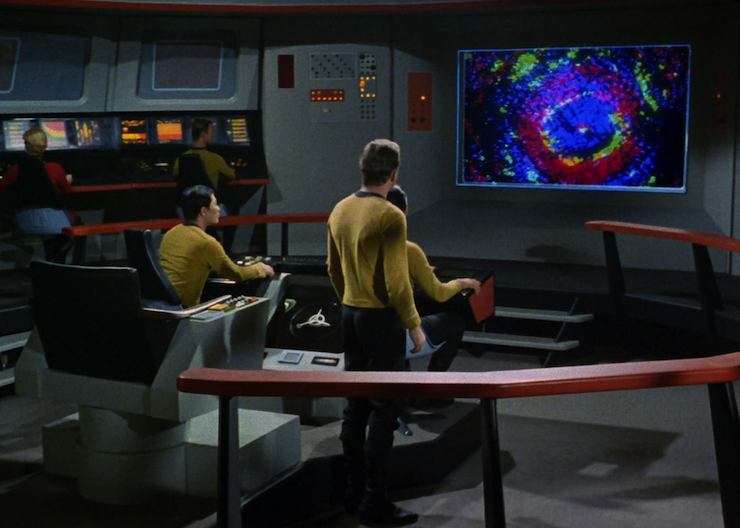
They have prepared a planet for Kirk and the Gorn captain (which is the first time the enemy has been identified by name) to battle against each other in individual combat. Elements will be provided for them to fashion weapons, and they’re equipped with translators that will enable them to talk to each other and record the combat.
While Kirk is faster than the reptilian Gorn, the Gorn is far stronger. Kirk records the equivalent of a log entry on the translator, which the Gorn listens to. The Metrons promised material to fashion weapons, and so both seek out such material. The Gorn works on a tripwire, while Kirk finds a mess of diamond shards. Kirk tries dropping a really big rock from high up onto the Gorn’s head, which knocks the Gorn down, but by the time Kirk makes it back down the outcropping he dropped it from, the Gorn is getting up. So Kirk runs away, right to the tripwire, which drops a bunch of rocks right on him. The Gorn has also fashioned a knife from a piece of rock, and he attacks Kirk with it. Only Kirk’s greater speed saves him—even limping, he’s faster than the Gorn and manages to stay ahead.
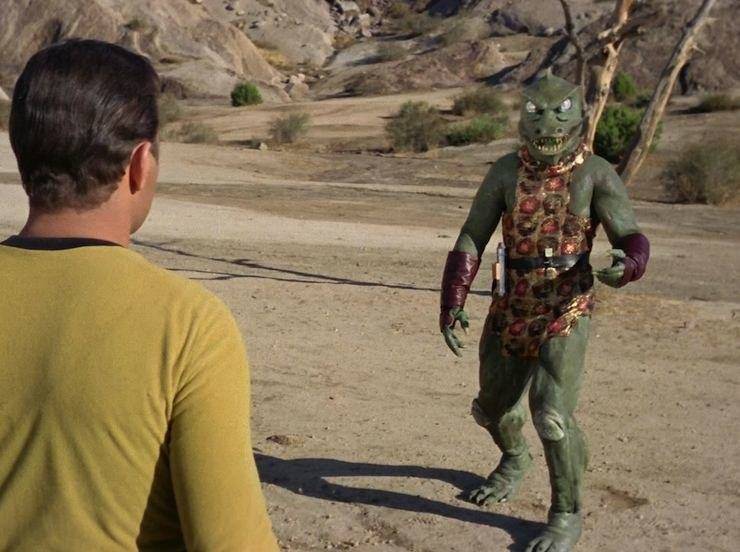
On the Enterprise, Scotty has tried every trick in the book to fix the ship, to no avail. Spock tries contacting the Metrons to parley. The Metrons magnanimously decide to let the crew see their captain’s final moments.
The Gorn talks to Kirk, requesting that Kirk stay put for a merciful death, as he’s weary of the chase. In addition, the Gorn reveals that Cestus III is within Gorn space, and they viewed the establishment of a base there as the first wave of an invasion. The Gorn were only protecting their own.
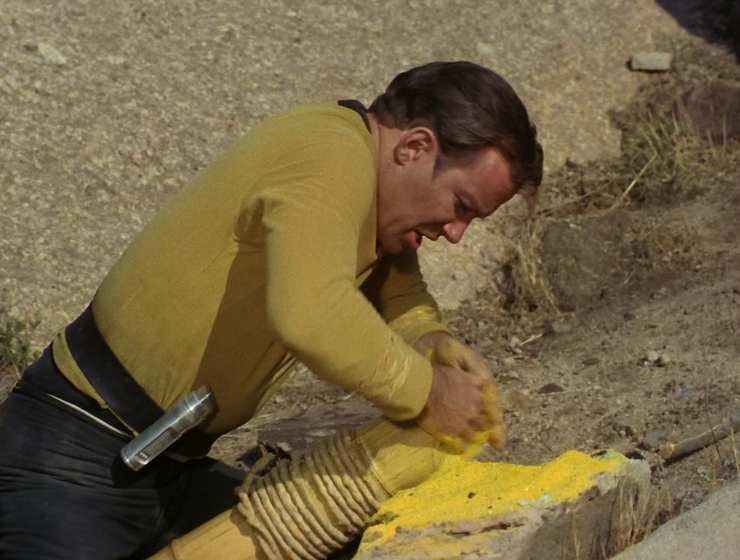
Kirk finds a deposit of sulfur, and then later finds potassium nitrate. He then gathers a hollow wooden tube and a bit of stringy stem. He puts the potassium nitrate and the sulfur in the tube, and uses the diamonds as projectiles. He finds some coal, adds that, and then mixes it all up after crushing the coal. He uses the stringy stem as a fuse, lights it with a piece of cloth and fires the diamonds right at the Gorn’s chest.
The Gorn is at Kirk’s mercy and he is about to stab him in the chest with his own knife—but then he stops himself. If the Gorn saw the establishment of the outpost as an act of war, then he was only defending his territory.
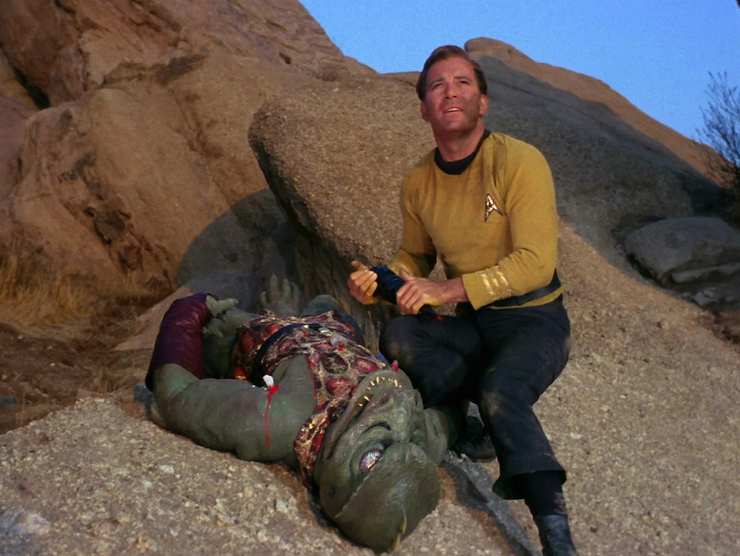
That act of mercy saves Kirk, as one of the Metrons explains. He sends the Gorn back to his ship, and offers to destroy them, but Kirk says no, they can talk and work out an agreement.
Kirk reappears on the bridge. Sulu is shocked to see that the Enterprise is somehow halfway across the galaxy from where they’re supposed to be. They set course back to Cestus III and, with luck, a proper first contact without all the violence…
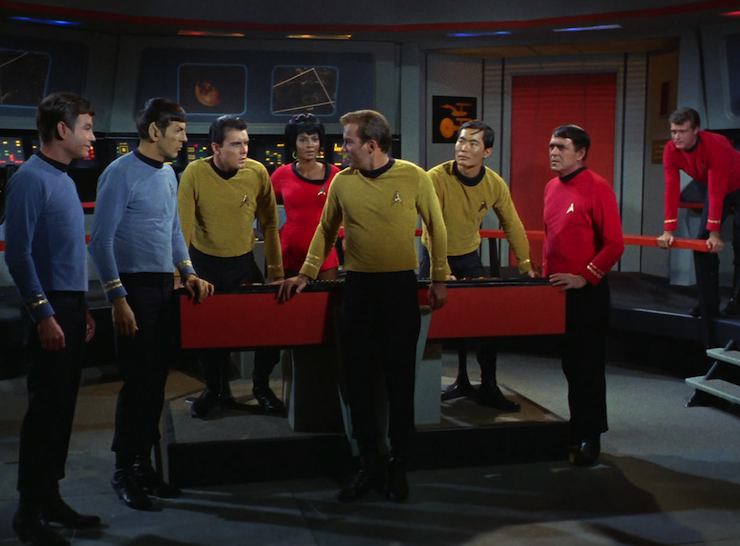
Can’t we just reverse the polarity? The Metrons are kind enough to leave all the material necessary to make gunpowder.
Fascinating. Spock tries to point out to Kirk that there could be any number of reasons why the Gorn massacred the Cestus III colony, but Kirk won’t hear of it, insisting that there is only one possible explanation. And then when the Gorn captain tells him that the establishment of the colony on that planet was viewed as an invasion, he realizes belatedly that he probably should’ve listened to his first officer.
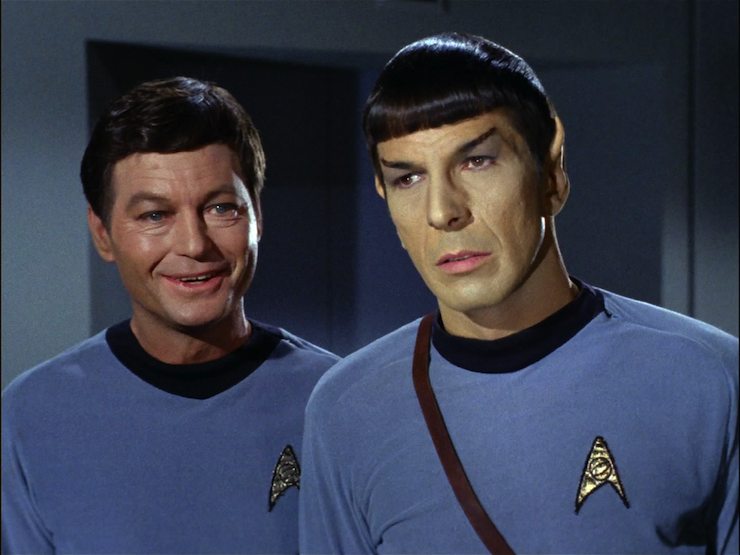
I’m a doctor not an escalator. When McCoy waxes rhapsodic about Travers’s hospitality, in particular his chef, Spock dismissively says that the doctor is a sensualist, to which McCoy replies, “You bet your pointed ears, I am.”
Ahead warp one, aye. As implied in “The Man Trap,” when Kirk assigned Sulu to put the ship at general quarters and search for the salt vampire, Sulu is considered third in command of the ship. This is the first of two occasions in the first season where Kirk will leave Sulu in command during a combat mission, the next being “Errand of Mercy.” Spock also reminds Kirk that Sulu is an experienced combat officer, which is pretty impressive for a guy who was the ship’s physicist not that long ago…
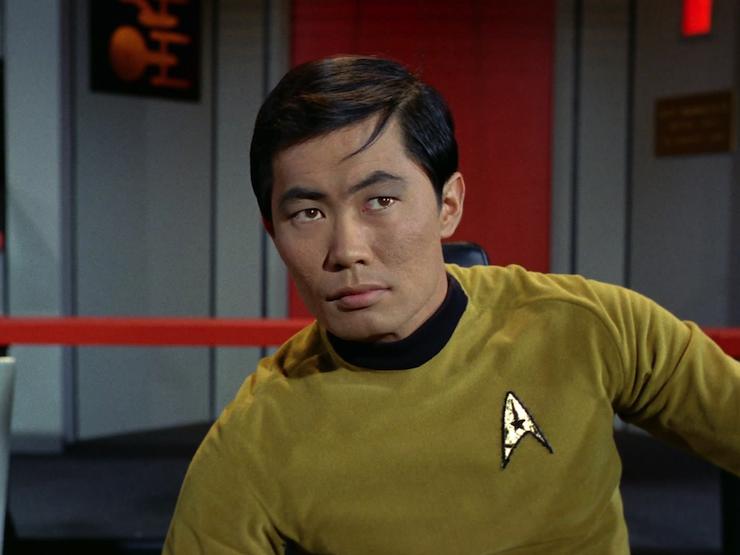
I cannot change the laws of physics! Scotty looks pained when Kirk asks for higher warp speeds, but says nothing. When Spock makes suggestions on how to bypass the Metrons’ iron grip, Scotty says he already tried everything Spock suggested.
Hailing frequencies open. When Kirk disappears from the bridge, Uhura lets out a huge scream. Until Star Trek V‘s fan dance, it was the single most undignified moment the character had.
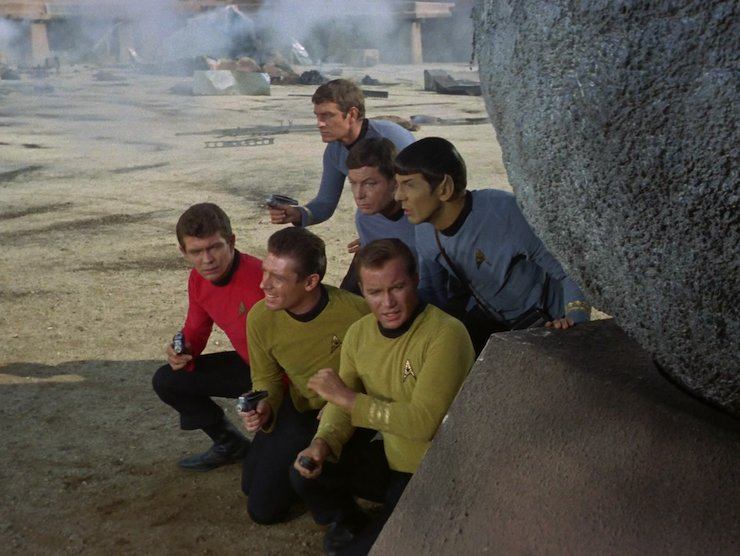
Go put on a red shirt. Two of the three tactical experts—who are, in a sop to NBC’s recent adaptation of full color broadcasting, wearing each of the three possible colored shirts—are killed. Lang doesn’t even get to be killed on camera, the poor bastard.
Channel open. “We’re a most promising species, Mr. Spock, as predators go—did you know that?”
“I’ve frequently had my doubts.”
Kirk giving the moral of the story and Spock being a doubting Thomas.
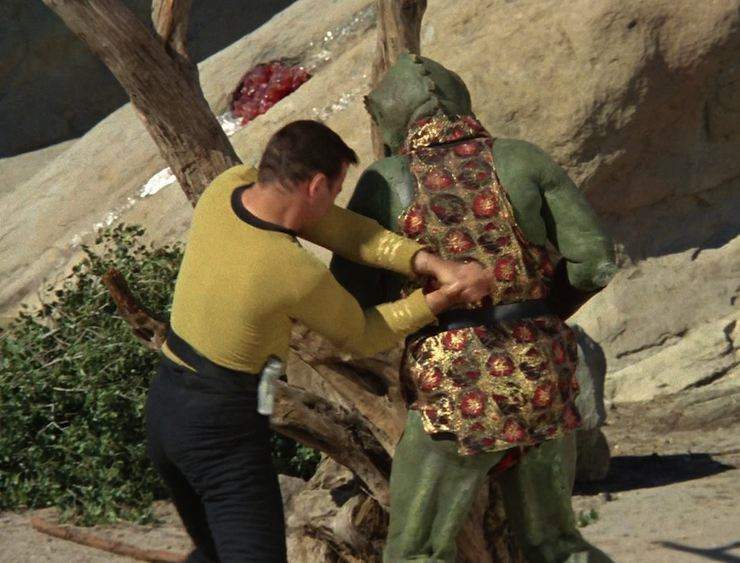
Welcome aboard. The Gorn captain was played by four different people: William Blackburn played him in head-shot closeups, Bobby Clark and Gary Combs both played him in longer shots, and Ted Cassidy provided the voice. Clark later “reprised” the role in a promo with William Shatner for the Star Trek videogame released in 2013.
The Metron was played by two people: Carole Shelyne physically played the role, but the Metron’s voice was provided by an uncredited Vic Perrin, probably best known as the voice of the classic opening to The Outer Limits.
Jerry Ayres, Grant Woods, and James Farley play the Enterprise tactical experts in the landing party, Tom Troupe plays the Cestus III survivor, Sean Kenney (the injured Pike in “The Menagerie“) makes the first of two appearances as DePaul, the latest member of the navigator derby, and we have recurring regulars DeForest Kelley, George Takei, James Doohan, and Nichelle Nichols.
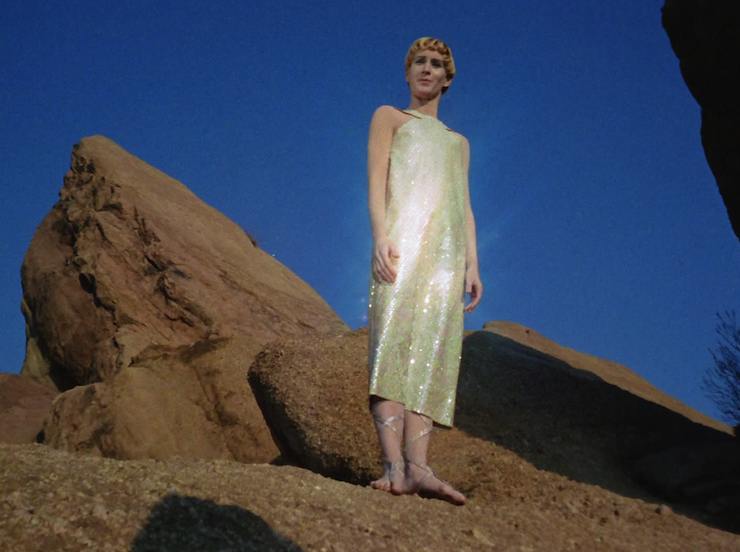
Trivial matters: This is the first episode scripted by Gene L. Coon, who was the show-runner for the back end of season 1 and all of season 2, and also the first directed by Joseph Pevney. Pevney was brought in by Coon because of his reputation for filming fast, and he got this episode done in six days instead of the usual seven (which earned him a bonus). Pevney went on to direct thirteen more episodes of the original series (including the two episodes that tend to hit the top of most folks’ best-of lists, “The City on the Edge of Forever” and “The Trouble with Tribbles“).
Coon’s original script had the Metron admitting that their plan was to destroy the winner of the conflict, as that side would pose the greatest threat to the Metrons. But Kirk’s showing mercy changed their minds. That bit was in James Blish’s adaptation in Star Trek 2.
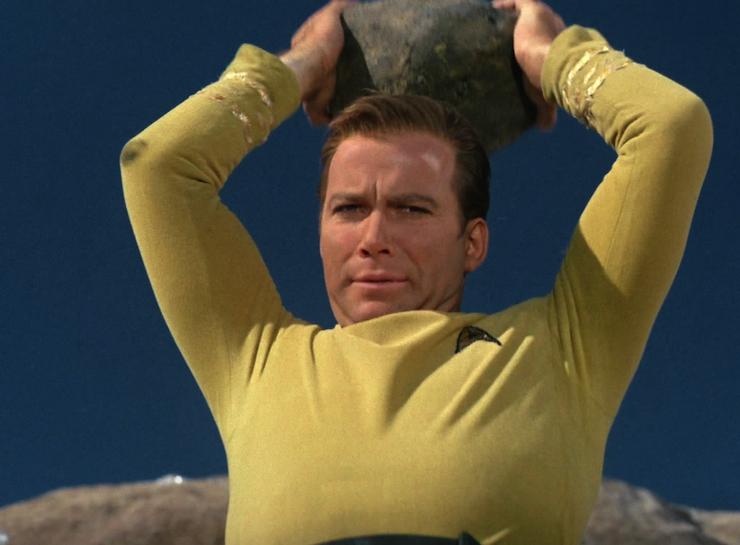
Fredric Brown’s story credit was due to Coon’s script being unintentionally similar to a short story by Brown with the same title that was published in Astounding Science Fiction in 1944. After the similarities were pointed out to Coon, he bought the rights to (retroactively) adapt the story.
Of all the Trek episodes that did location filming at Vasquez Rocks, this is probably the most famous. The movies Bill and Ted’s Bogus Journey, Jay and Silent Bob Strike Back, Free Enterprise, and Paul all have homages to the use of the rocks in this episode.
This episode is the first one that mentions the Federation by name. All episodes prior to this have implied that the Enterprise is purely an Earth ship (despite having Spock on board).
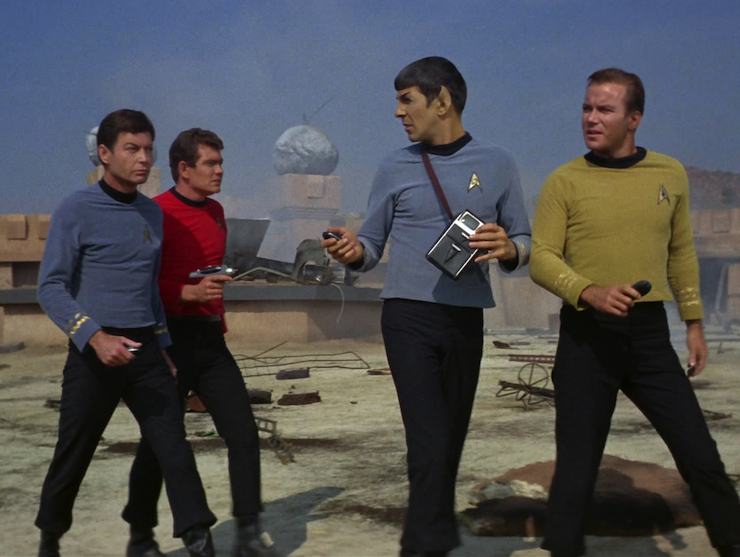
Cestus III will have become a Federation colony by the 24th century, according to DS9‘s “Family Business,” where it’s established that Kasidy Yates comes from there. Your humble rewatcher established a bunch of stuff regarding Cestus III in the novels A Time for War, a Time for Peace, Articles of the Federation, Q & A, and A Singular Destiny, all of which have characters from that colony.
The Gorn won’t be seen again onscreen in the mainline timeline, though the Gorn of the Mirror Universe will be seen (rendered with CGI rather than a guy in a suit) in the Enterprise episode “In a Mirror, Darkly.” They are used extensively in the tie-in fiction, most notably The Gorn Crisis by Kevin J. Anderson, Rebecca Moesta, & Igor Kordey, which established a culture and society for the Gorn that has informed all subsequent appearances of the Gorn. In addition the Gorn have been part of the Typhon Pact that has served as an antagonist to the Federation in recent 24th-century novels.
One of the onscreen mentions of the Gorn is in DS9‘s “Trials and Tribble-ations,” when Sisko tells Dax that he’d love to ask Kirk about facing the Gorn on Cestus III.
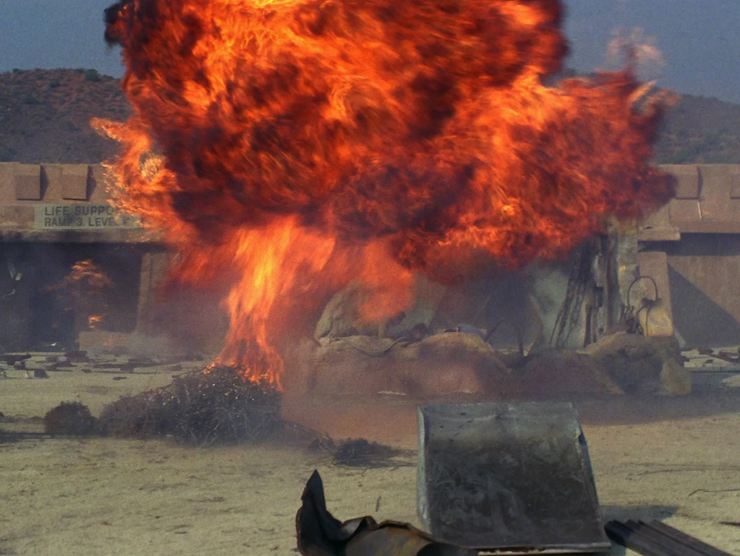
To this day, William Shatner suffers from tinnitus due to a special-effects explosion during this episode.
An episode of Mythbusters attempted to re-create Kirk’s makeshift cannon, and determined that it couldn’t be done, with the caveat that the properties of the wood on an alien planet might be different…
To boldly go. “You are still half savage.” This episode is a classic example of what made Star Trek unique in the late 1960s. In an era where World War II wasn’t that long ago, in an era when the Cold War was at its height, the notion of an enemy out to destroy our way of life was on everyone’s minds, whether it was Germany, Japan, and Italy two decades previous or the Soviet Union and their allies in the present.
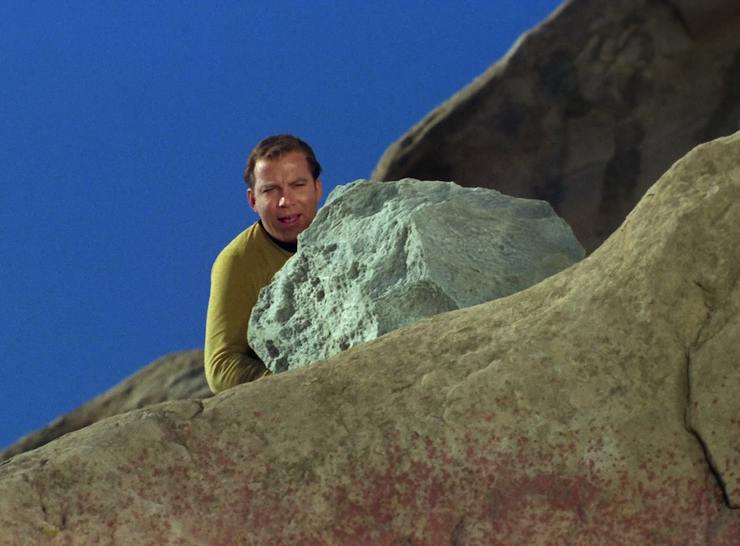
Not that the notion has gone away five decades later, but the popular culture of the time tended toward a black and white view. Any other adventure show would have had the same story beats for the first three acts, but a much different fourth act, in which our hero would have struck the fatal blow against the evil bad guy. And we know he’s evil because he hisses and snarls and looks like a lizard and he ordered the deaths of all those people.
But Star Trek didn’t do that. Star Trek had the Gorn captain have the same attitude toward the establishment of a colony on Cestus III that Kirk had returning from that planet after the Gorn attacked it: it has to be an invasion, there’s no other possible explanation. And because both sides reacted with violence rather than talking, more people died. It takes an act of compassion on Kirk’s part to stop the violence and get the two sides talking to each other.
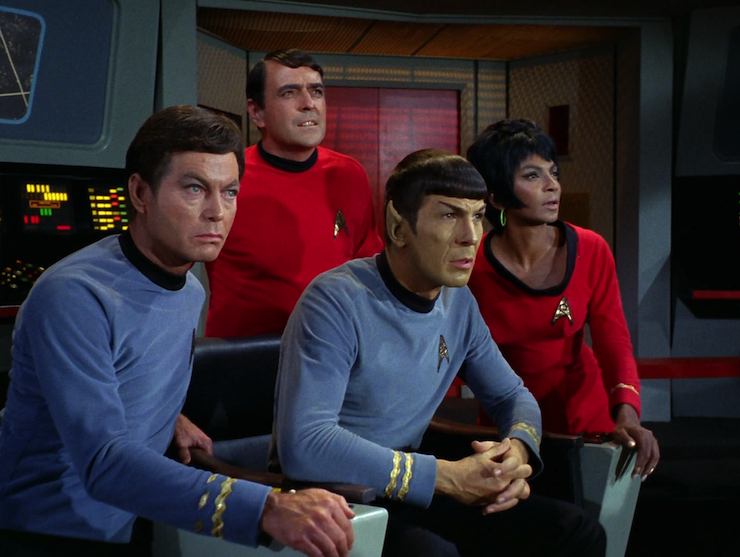
We never do see the results of that talking, though the fact that Cestus III is a Federation planet in the 24th century indicates that some kind of agreement was come to.
But the point is that the talking was the end result. This sort of story with that kind of twist is commonplace now, but Star Trek was one of the first to do it—and unlike other genre shows that pulled this kind of switch like The Twilight Zone and The Outer Limits, the twist wasn’t there for the sake of pulling a fast one on the viewer or to reveal a more devastating unexpected truth. No, the twist here comes from a place of compassion, of enlightenment, of making a mistake and realizing it.
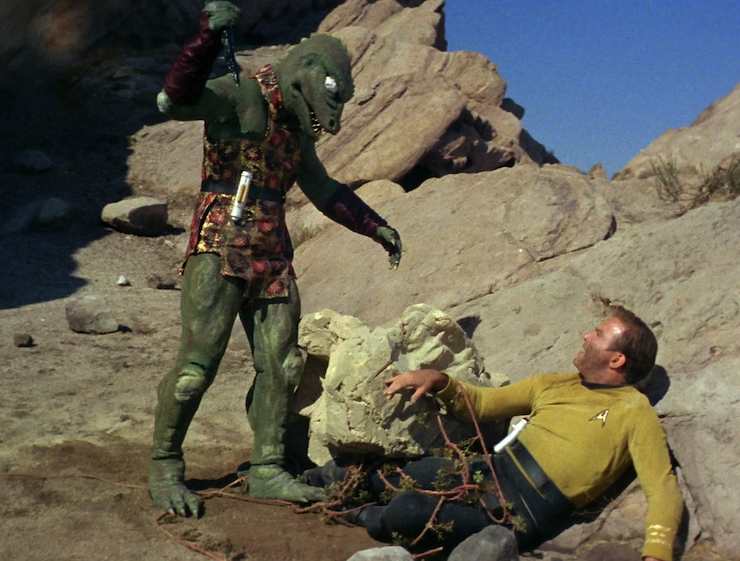
The episode isn’t perfect. Neither of the devices used to convey exposition to the viewer—Kirk narrating into the Metron-provided translator/communicator, Spock explaining everything to the bridge crew as they watch—works particularly well, and slows the climactic action. But when the script allows director Joseph Pevney to just show the action, it’s superlative, a great use of the Vasquez Rocks location (both in the captain-captain fight and in the earlier scene on Cestus III when the landing party’s being shelled). But ultimately, it’s about the dangers of space and of quick judgments, and of the power of compassion and mercy. Those are all worthwhile as storytelling devices and as morals. Bravo.
Warp factor rating: 9
Next week: “The Alternative Factor”
Keith R.A. DeCandido is involved with two nifty Kickstarters, one for a superhero anthology called The Side of Good/The Side of Evil (in which Keith will have a story), the other for a web series that combines 50s and 60s pulp sci-fi with a modern sensibility (think Buckeroo Banzai meets Emma Peel) starring Singularity & Co.’s Cici James called Atomic Annie (for which Keith will be putting together a short-story anthology).










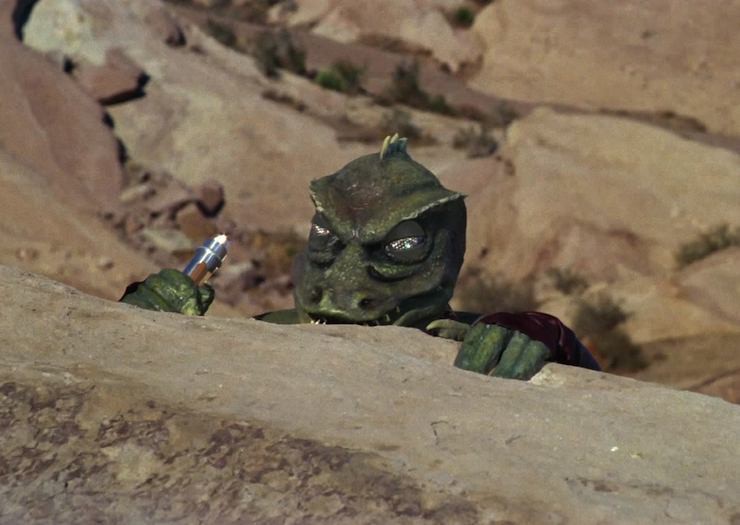

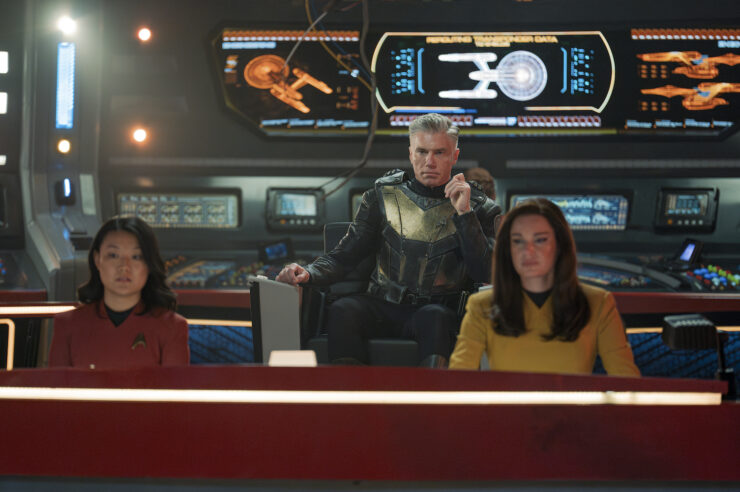
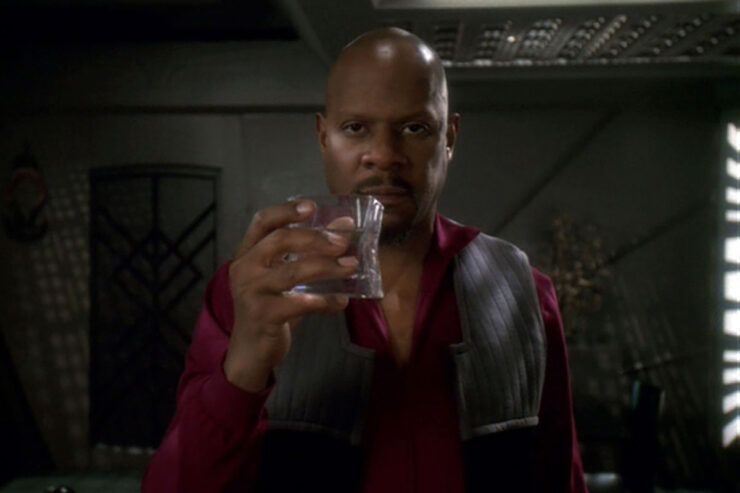
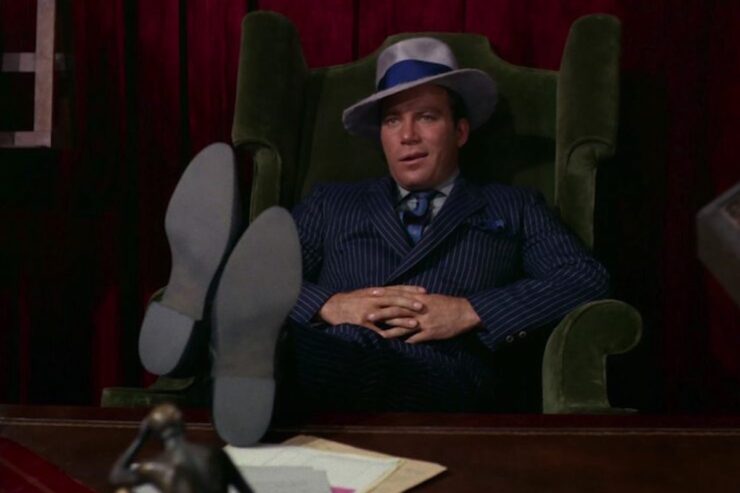
Honestly, the pacing has always been rough on this one for me. I’d knock it down a point or two for that; the moralization at the end doesn’t make up for the pacing to me.
Until this moment, it somehow escaped me that the Metron was played by a woman. Somehow I have been a Star Trek fan for all this time and missed that…
I cannot imagine the suffering the actors in the Gorn suit went through. Do we have any idea what the temperature was like that day?
The episode is iconic but also often ridiculed for the fight between Kirk and the Gorn.
But I think it’s a totally great confrontation. It establishes a fictional race and during the fight we learn about the physical traits of the Gorn (slow but almost invulnerable). So the slow speed of the fight is a successful establishing of a truly different species. Kirk totally tries his best with fast moves and progressively heavier weapons, but as the fight progresses the active action hero seems to be useless. The ridiculously slow moving Gorn totally subverts what we think about agility being positive because he basically can’t lose. It gets even better when the hissing creature is intelligent enough to set a successful trap. While we know that the Gorn must be advanced, seeing such a Reptilian person probably provokes certain reactions based on the looks of him.
Kirk in the end wins because he is forced to think as far as possible while the Gorn having the upper edge doesn’t realize the weapon potential on the planet. It’s a close fight and a nice example how to set up an alien character in fantastic fiction whose abilities look nevertheless real and believable to the viewer.
I do appreciate the very Star Trek moral to this episode, but there are sure some clunky parts getting there. Spock’s narration in particular, didn’t work for me.
I assume that whatever treaty the Federation worked out with the Gorn, it involved some sort of agreement to at least issue a warning before you kill everyone who’s moved onto one of your planets. Because even if you think you’re being invaded, we see here that the Gorn clearly have the means to communicate with humans, so Plan A being to just kill them all immediately was seriously a jerk move.
-Andy
So many of these classic episodes are the foundation of so many tropes (especially Gothos last week and Arena this week) that it is hard for me to really appreciate them as if I was seeing them in 1966. Kudos to Keith for being able to look past all the parodies and knockoffs that came after, and just think about the show as it was.
@3/Andy – Do the Gorn have the means to communicate with humans? Nothing at all is said until they’re on the planet, and by that point they have the Metrons’ gear for that.
I agree that the episode deserves credit for the dtory/thematic elements you mentioned. However, I must say that the appearance of the Gorn, like so many early Dr. Who monsters, has–shall we say–not withstood the test of time so well. It may have scared me a bit as a kid, but now it elicits a smile from this viewer.
@5/MeredithP
The episode opened with the Gorn faking a communication to the Enterprise, so yes, the Gorn do have the ability to communicate with humans, and they can do it well enough to fool us.
@5/MeredithP — Well, we know that they were somehow faking communications with Kirk, so even if it’s through artificial means, it would appear that they can translate and communicate in English/Federation Standard even without the Metrons’ help. Unless I’m misremembering, maybe?
[EDIT: Whoops! lerris just said the same thing.]
@6/Don S. — Yeah, I very much preferred the redesign the Gorn got when one appeared on Enterprise. Though I think that was more of a fast raptor type dinosaur, and I’d forgotten that the Gorn’s slowness was specifically a plot point in this episode. So I guess any redesign has to make them still look lumbering, huh?
–Andy
@6/Don S. – But watch the remastered version. Like the Ewoks on the Return of the Jedi Blu-ray, the Gorn now blinks. Scary all over again! ;)
I like this episode – I even chose it as the most “definitive” TOS episode of Season 1 for the Trek.fm blog – not only for its own merits, but also because it held my son’s attention when he watched it for the first time, at about 6 or 7. He’s amost 14 now, and I haven’t been successful in getting him to try more Trek with me yet (well, I take that back – he’s seen the two JJ films…), but he still remembers liking “Arena.”
@3/AndyHolman: The fact that the Gorn are not nice and it’s totally over the top to kill everybody on their planet makes the ending even better. Yes, they are jerks, but it is still a good idea to work out a treaty with them.
@2/Lubitsch: Kirk does a lot of running around before he realizes the weapon potential of the planet. Being much slower, I wonder if the Gorn captain ever had a chance to find all the necessary stuff in the first place.
RE: Kirk’s cannon,
At least he didn’t form some sort of rudimentary lathe:
https://www.youtube.com/watch?v=EQG3I5efwWo
An iconic episode and one of my favorites when I was a boy.Solid plot, good action, nice moral:Overall grade: 8
Various comments:
Slow Gorn: Sue me.I like the fact that it was slow.This was a classic duel: strength vs speed, nigh invulnerability vs agility, etc
The Wild Final Frontier: You can really feel the Western influence on the episodes opening.It’s the classic returning to the fort/homestead/town, only to find that it has been wiped out by an Amerind raid (cf The Searchers and a million other Western flicks)
It gets cold in the desert: Look closely at Kirk during his struggle against the Gorn.Instead of the standard black T-shirt, he’s got some kind of white, thermal-looking undergarment on underneath his shirt.
High heels are dangerous: Also note how the Metrons have helpfully supplied Kirk with flats.Wouldn’t want to see him twist an ankle out there…
Galaxy Quest: And, of course, this episode was referenced in Galaxy Quest ,and, it goes without saying, that Galaxy Quest is one of the finest Star Trek films ever made….:
https://www.youtube.com/watch?v=EQG3I5efwWo
I wonder if the Gorn captain was exceeding his authority? Not only did he jump to conclusions and massacre an entire outpost, but he went out of his way to lure a starship crew into a death trap. Sounds less like an innocent misunderstanding than like someone hoping to start a war and paint himself as the big hero – maybe run for president, as Custer hoped to? Did he face disciplinary action once the whole thing went on the record? If the bit about the Metrons planning to destroy the winner’s ship had been kept, it would have looked even worse for him…
It’s a statement of what “Star Trek” was all about that in the original short story, the ending was exactly the predictable one that KRAD describes: The alien, depicted as utterly evil, and its entire bunch of Evil Aliens are wiped out. The difference, perhaps, between McCarthy-era paranoia and the Sixties’ more enlightened worldview.
It’s worth pointing out that in real life, the Cestus III outpost was just a few hundred yards away from the Metron asteroid. It was a “Western fort” movie/TV location that used to stand in Vasquez Rocks, but has now been torn down.
On my one visit to Hollywood back in ’96 or thereabouts, the one place I insisted on visiting was Vasquez Rocks. When I saw “Arena” again after having been there, it was a revelation how much the episode cheated with the geography of the location, using different parts of the same central area as if they were separate places, and altering their apparent spatial relationship to each other. After all, they were limited in where they could point the camera without revealing that “Cestus III” was right over their shoulders.
Gene Coon did a terrific job here thematically, setting up the Gorn as a classic scary monster and then subverting our expectations and revealing that it was the Federation who’d been in the wrong, recklessly expanding and not realizing they’d intruded on the territory of a highly territorial people. It’s a brilliant and powerful twist. Which is why I hate it that a lot of fans and even some writers still jump to the conclusion that the Gorn are vicious, evil monsters. I disliked The Gorn Crisis for taking that route at first, until I realized that the villains were a militant faction that had overthrown the rightful rulers.
By the same token, I’m not crazy about DS9 revealing that Cestus III ended up in Federation hands. That seems like getting it backward, unthinkingly embracing the very notion of Federation manifest destiny that “Arena” was all about challenging and problematizing. The whole point was that the Federation didn’t have the right to be on Cestus III. It’s hard to see why the Gorn would cede it to them, and I don’t like the unthinking implication that the Federation was somehow entitled to have it. If DS9 just wanted a throwaway continuity reference to a TOS planet, they should’ve picked something else, like Benecia or Ariannus.
On the subject of the bamboo cannon and whether it would’ve worked, it’s important to keep in mind that the planetoid was by no means a natural environment. It was, well, an arena, a controlled setting created by the Metrons. After all, you’d never find “charcoal deposits” in nature. Charcoal is an artificial product, the result of burning wood in a specific way. You probably wouldn’t find big chunks of diamond or piles of powdered sulfur just lying around on the open ground either. They were put there deliberately by the Metrons. It’s possible that the whole environment was some kind of holodeck or equivalent controlled setting. Realistically, as the Mythbusters showed, it’s hard to mix gunpowder in the right ratio to be effective; the odds of Kirk getting just the right mix on his first try, purely by eyeballing it, were vanishingly low. But since the whole thing was really an intelligence test by the Metrons, it’s possible that they arranged for the cannon to work even though it wouldn’t have under normal circumstances.
Oh, and one thing about the Metrons: A lot of people have the impression that the Metrons are yet another race of energy beings, mainly because of the sparkles that surround the Metron who appears toward the end. In fact, those sparkles were just an accident, light reflecting off Shelyne’s shimmery costume into the camera lens (although the TOS Remastered edition added some animated sparkles to make them look more deliberate). There’s not a thing in the dialogue to suggest that the Metron is incorporeal or anything more than a really long-lived humanoid. I suppose there are just so many energy beings in TOS’s first season that there’s a tendency to expect any advanced race to be energy beings, especially with the sparkles. But the Metrons are probably more in the category of advanced, ancient humanoid races like the Talosians.
@14 Christopher L Bennett:
RE: Cestus III becoming a Federation Colony,
It’s important to remember that the Gorn did wipe out a Federation outpost on the planet.Yes, the Gorn were responding to what they thought was an invasion, but people did die. I could see the Gorn, in the spirit of reconciliation, allowing the Federation to maintain a presence there.Heck, for all we know, the planet might be mutually administered by both the Federation and the Gorn, a more successful version of the “Planet of Galactic Peace” idea that we saw in STAR TREK V: The Final Frontier
I like the design of the Gorn in this episode despite the limitations of TV creature effects at that time. The insect-like eyes are unique, and I was disappointed when Enterprise went with a more standard reptilian look for their Gorn. And though I only saw the trailers, the Star Trek game that came out a couple years ago seemed to have gone in a similar direction with the creatures. A bunch of growling, hissing monsters. Staying true to the spirit of the Abrams movies, I guess.
@15/trajan23: And if DS9 had actually acknowledged that, if they’d stated that Cestus III was a joint Federation/Gorn world, that would be fine. But they didn’t. They just carelessly, casually treated it as a Federation world without any acknowledgment of the questions that raised. And that seems to me like missing the point of “Arena.” I’m not talking about whether fans can invent clever rationalizations after the fact. Anything can be rationalized after the fact; heck, it’s a large part of what I do as a Trek novelist. My point is that I don’t think the DS9 writers who chose to use Cestus III in that way were really thinking it through or realizing why it was a problematical choice. Which is why I said that if they just wanted a throwaway Easter egg, they should’ve picked a planet with less complicated issues around it.
Has the Universal Translator appeared yet? If not, then obviously Kirk palmed his and had it reverse engineered. Probably at Starbase 51.
I’m glad Cestus III is a Federation world, otherwise I wouldn’t be able to wear my Pike City Pioneers shirt at ball games.
@18/sps49: Nope, that prop wasn’t referred to as a Universal Translator until “Metamorphosis,” the second episode produced in season 2.
Maybe it would have been better had they mentioned Cestus III being a trading post between the Federation and the Gorn. After all, there was no Gorn colony on the world. It seems to be far from the Gorn population centers as the Federation is only vaguely aware that there might be a starfaring power in this part of the galaxy (though one wonders if the rumors are actually about the Metrons). The Federation apparently intended to make the colony an open port, which made the initial attack more morally questionable then Kirk’s response to it. The Gorn government might have seen a point of contact of more value than a planet they perhaps were not capable of exploiting.
One of my favorites as well.
Like the Corbomite maneuver, I loved that it was intelligence and diplomacy than won over brute force. The whole flipping of the perception of the invasion from the Gorn’s point of view was great.
It’s a great Trek episode IMO because it makes you think.
And I totally agree about the addition of the blinking : subtle but very effective !
Did anyone else see the grenade launch on Cestus III as a kind of foreshadowing to Kirk building and using a similar looking but more primitive weapon later in the episode?
#11 @trajan23, I’m so glad you brought up Galaxy Quest, as I put that part with the “rudimentary lathe” and this episode together in my mind. I can’t think of one without thinking about the other.
I always feel that Kirk looks a bit slow-witted in this episode when he keeps talking about “finding the weapon the Metron mentioned”, as if expecting to find a gun, or a sword, lying around. The Gorn captain is much quicker on the uptake, since he starts building weapons almost immediately. Handicraft work probably wasn’t Kirk’s hobby when he was a kid :-)
Then, all of a sudden, he has the bright idea of making gunpowder. And all this without even getting his shirt torn.
Also, I would like to have one of those Metron transporters that transport people and their clothing, but leave all the dirt behind. A very useful household item!
Huh, I thought it was established somewhere in the novels that 24th-century Cestus III was a joint colony. If nothing else, Nan Bacco seems to have a lot of Gorn friends (who appreciate baseball), so I’d assume there’s a sizable Gorn population living there. I like to think the Gorn/Federation conflict has become subsumed into particularly emotional annual baseball playoffs.
@13. Maybe not just exceeding his authority, but the slow movements make me think he might also be elderly (there’s “slow” and there’s “having joint trouble”). Maybe at the tail-end of a mediocre career, looking for one last Victory to establish his Legacy. . .
Not a huge write up from me on this, better thinkers than me have long since said everything I think. BUT!
This is the first Trek episode I think that helped my father and I start to develop a friendship, and it’s also the episode that drew me into Star Trek.
And because it was mentioned (Cestus III being a home planet for some in the trek novels): Poor President Bacco, she was a great character in the post Nemesis books.
Ranbom bit of trivia: the Gorn are a playable race in the Star Trek Online multiplayer online game. I know because I played one for some time.
This is the first episode scripted by Gene L. Coon, who was the show-runner for the back end of season 1 and all of season 2
Aside from his burning out midway through season 2 and being replaced by John Meredyth Lucas?
Nevertheless, I enjoy discovering new facts about Trek after so many years. I had no idea Coon was the one who brought Joseph Pevney into the directing rotation. Now I understand why Pevney stopped directing the minute season 2 ended.
Despite the unintentially clumsy and humorous depiction of the Gorn’s battle tactics and Shatner’s attempts to dodge him, I always enjoyed this episode. Pure visuals driven by actions without getting bogged down by dialogue. Very well done, especially by 1966 standards. Great use of location, well told story with some real stakes and a truly great Trekkian ending without resorting to becoming an overt morality play. Definitely one of the show’s best endings, second only to City on the Edge of Forever’s.
And Coon proves to be pretty adept at following the rules of Roddenberry’s universe, and getting the voices of these characters just right, while printing his own identiy into these stories. And he manages this despite being the earliest post-Roddenberry showrunner. I mention this because he could have been a real problem case, given Gene’s tendency to get confrontational with other Trek producers. It’s too bad not all writers felt comfortable writing for Trek. I’m mostly thinking of TNG era writers in this case, namely Michael Wagner, Frank Abatemarco and Lee Sheldon.
I haven’t read that many Trek novels, but I like to think the Gorn did eventually come to terms with the Federation. Hence, we get Cestus III as a Fed colony. I’m still waiting for that DS9 episode where Kasidy takes Sisko to the dugout seats.
correction: unintentionally.
@25/Jana: Kirk does tear a strip off his uniform trousers to use as wadding for the cannon. So it’s not his shirt for a change, but there is tearing.
And the disappearance of the dirt on Kirk’s uniform when he’s returned fits with my hypothesis that the whole thing takes place in a holodeck or equivalent.
@26/Cybersnark: It probably has been established as a joint colony in the novels, but my problem is not with the novels. It’s the writers of DS9 that I feel missed the point of “Arena.” The novels (including the Gorn Crisis graphic novel) have handled the whole Gorn/Cestus situation better than the show did, if only by remembering that the Gorn existed in the first place.
@31/Christopher: Yes, I noticed the tearing, but I fully expected a torn shirt and was pleasantly disappointed that there wasn’t any.
Linking the disappearance of the dirt to the artificiality of the surroundings you mentioned is a good idea.
@10/JanaJanson – Oh, for sure. The ending to this episode is pretty much pure Star Trek in all the right ways.
I always think of this episode as the one where Kirk fights the Gorn — I’d forgotten that it’s yet another instance of a [seemingly] omnipotent being messing with the crew! This is one of the rare times they do so in the pursuit of peace, as I recall, just as they would in “Day of the Dove.”
-Andy
@33: And in a way, also the Organians on Errand of Mercy, which was also written by Coon.
@34, Oh, yeah, that’s actually the episode I was thinking of! Turns out “Day of the Dove” was one where the omnipotent beings were trying to cause violence instead of trying to stop it. Know wonder it’s easy to get all of Trek’s omnipotent beings confused.
@33/AndyHolman: Well, as scripted, it wasn’t really in the pursuit of anyone’s peace but the Metrons’ own. They were going to destroy the winner, because the better fighters would be more dangerous to them.
Same for the Organians, really. They just wanted the noisy kids to get off their lawn. They couldn’t stand the presence of corporeal beings, and as long as there was a war on, Organia would be a strategic target and the horrible little meatbags would keep bothering them. So they ended the war purely for their own comfort.
@Christopher: I like it that your description of the Organians’ actions borders on stereotyping. But in this case, I think it applies. The fact that Kirk and Kor had their decision taken away from them in such a simpleminded fashion allowed for the Klingon/Federation tension to remain constant despite the presence of a treaty. And it would give these characters time and room to grow past their prejudices and finally take some real initiative towards peace by ST6.
It’s a pity the fight didn’t last longer. In the Blake’s 7 episode, “Duel,” characters in a similar situation have to stop trying to kill each other when it gets dark and make camp.
When one of the crew (Avon) watching on the space ship decides to get some sleep as well, another character asks him how he can go to sleep with all this happening. He says:
“With all what happening? Blake is sitting up in a tree; Travis is sitting up in another tree. Unless they’re planning to throw nuts at one another, I don’t see much of a fight developing before it gets light.”
Ellynne: Always loved that line of Avon’s. :)
—Keith R.A. DeCandido
Always loved this episode. Alas, my daughter found it boring when I screened it for her.
Interesting note: Peter David tried to bring back the Gorn during his run on the second DC TOS comic-book series, but the guy at Paramount who was in charge of approving the tie-in fiction objected to the way the Gorn was portrayed, so the character was recolored, given a bad toupee, and called “the Lath,” with the dialogue exchange between him and Kirk rendered incomprehensible.
@40/Glenn: Hmm… I wonder if it’s a coincidence that when Marvel’s Star Trek Unlimited brought back the “Arena” captain (the same character that the “Lath” captain was presumably supposed to be) a few years later, they called him S’alath.
Anyway, the altered passage in PAD’s story wasn’t exactly “incomprehensible.” It’s just that they missed a few lines when they swapped out “Gorn” for “Lath” in the dialogue. So we get exchanges like: “The Lath!” “You’re familiar with the Gorn?”
I just wanted to report that The Menagerie is missing from the rewatch table of contents. Also, Court Martial‘s next link links to Shore Leave, and Shore Leave‘s previous link links to Court Martial. The Menagerie is still accessible via Court Martial‘s Next week link, though.
@42 – thanks, we’ll get those fixed as soon as possible!
I’ve just discovered that this episode contains a bit of on-the-nose planet-naming that I don’t think I ever recognized until now. Cestus is a term for a type of battle glove (often metal or spiked) used by gladiators in a Greek or Roman arena. A bit contrived, that. I wonder why the colony was called that in-universe, since presumably its founders didn’t intend for it to become a flashpoint in a gladiatorial contest between two species.
While we’re at it, “Metron” is from the Greek word for “measure,” which is appropriate for a race engaged in testing and assessment of other beings. Apparently it’s also used in the Bible to mean the sphere of influence or limited measure of authority granted to each human by God, which could also be considered applicable.
@44/Christopher: Interesting! In-universe, this makes even less sense than similar examples from “Dagger of the Mind” (Why would Adams name a seemingly humane penal colony after a guy who was eternally tortured in ancient Greek hell? Did Lethe’s parents anticipate that she would become a criminal and be made to forget her past? OK, maybe she changed her name…).
This one has it all: action, intrigue and interesting aliens. Kirk’s total frustration at being unable to injure the Gorn is very palpable and I’ve never minded the voice-overs.
One of my favorite Kirk moment takes place during the ambush of Cestus III. Kirk, while his landing party is under fire and already suffered several fatalities, takes a moment while setting up the grenade launcher to mentor Kelowitz, “An evaluation, Mister Kelowitz. Where do you think they are? To which Kelowitz replies, ” If I were them, I’d go to the high ground on the right. I make it twelve hundred yards, azimuth eighty seven. It’s pretty close for one of these little jewels, Captain.”
And Kelowitz is right! The grenade is launched, and the Gorn retreat off planet. A valuable opportunity under extreme pressure, for your captain to ask your opinion. Kirk didn’t need to ask Kelowitz to know what to do. But Kelowitz, if he was ever going to be a great officer like Kirk, or Sulu up above in charge of the Enterprise during a battle, needed confidence and real world experience, Has anyone written any fan fiction abut who Kelowitz, who Kirk obviously holds in high regard, became in his Star Fleet career?
Even today, the Gorn design and costume execution is awesome. Imaginative and fully conceived by the genius Wah Chang (look him up). It’s a bit plot artificial that the physically stronger Gorn is almost ridiculously slow, so Kirk can dodge and run away, awesome as their hand-to-hand combat is. Reptiles on our planet are not so slow. How did such a slow moving species as the Gorn become their planets apex predator? I did not like the Gorn design as much in “In a Mirror, Darkly Part II”, but did appreciate how much faster it was, even able to hunt Archer and his red shirts.
Anyone reading this who has The Wild Wild West on DVD or streaming, I swear that before that wide open space was used for the battle on Cestus II, it was used for a first season exterior on The Wild Wild West. Specifically and coincidentally, an episode produced or written by Fred Freiberger, who produced 10 first season episodes and wrote one. Many, many years ago, while watching this episode, Cestus III jumped right up out at me. I had no doubt. It was not a quick shot in the episode. And while I do not remember the episode title, while watching the credits I sure knew Fred Freiberger’s name.
@47/jackofwits: No professional tie-in author has ever followed up on Kelowitz that I know of, even though he was in three first-season episodes (“The Galileo Seven,” “Arena,” and “This Side of Paradise”). His only novel appearance I can find a reference to was in The Janus Gate, a trilogy set in between “The Naked Time” and “Charlie X.”
There is actually a long-held belief that reptiles are slow compared to mammals because they’re cold-blooded. That’s probably only true in colder weather for a lot of reptile species, but certainly some are slow by nature, like turtles, who’ve specialized more in armor than speed. Gorn are basically bipedal, bug-eyed crocodiles, and crocodylians tend to be fast on land only in short bursts. If they don’t get you on the first strike, you can easily get away.
And yes, I’ve seen that Wild Wild West episode. I remember there being a shot where you could see the famous Vasquez Rocks cliff through the entrance into the fortress location — so you could see the Metron asteroid from the doors of the Cestus III outpost. Vasquez Rocks has been used in many TV shows and movies over the decades.
@28 Months later, but a bit more random trivia: in Star Trek Online, a cosmetic option for Gorn characters is a set of eye pieces, interpreting the original, unblinking eyes of the Gorn Captain as protective armor.
Just happened to watch this again tonight on BBC, and I think what impressed me about this episode was the tightness of the dialogue, and how properly MILITARY the whole episode is (outside of the Show-down at the Lizard Corral, that is)…. The background dialogue, the status reports, the adherence to orders, the essentially professional analysis and response.
It’s all the little background details that make this episode work.
Another thing I noticed is that they perfectly rolled the matte painting of the onion domed structure in the walking scenes in the beginning of the episode to convey the feeling of distance to it. Details.
@50/Jeff: There was no matte painting. As discussed in earlier comments, the structure was an old fort set that used to be at Vasquez Rocks, just a few hundred yards from the iconic cliff formations used for the Metron asteroid later in the episode. The “onion domes” were just a bit of set dressing added to the fort entrance, probably lightweight fake boulders; the landing party shelters behind a third one at ground level during their first dialogue exchange in Act I. In the original episode, a distressed metal girder was placed on the top of the shot to obscure the horizon, perhaps to conceal some sign of civilization (most of the “asteroid” cliff formations would’ve been to the left of frame in the wide shot, and you can get a glimpse of the big cliff through the entrance behind McCoy and one of the redshirts a little past 3:00). I used to think it was a crude split-screen representing some kind of alien mountainscape until I saw a cleaned-up version. In the Remastered edition, they replaced it with a digital mountainscape.
I really, really hate being condescend d to by we’re-so-enlightened aliens. The fact you’ve got a fancy bag of tricks doesn’t make you superior.
That said it’s just as well the Metrons interfered in this case. Without the face to face contest and Kirk’s act of mercy convincing the Gorn that maybe we humans weren’t the aggressors they thought we were the destruction of the outpost would almost certainly have led to war and further atrocities by both sides. I wonder if the Gorn ceeded the planet as reparations for the human deaths? I also wonder what history with humanoids led them to take such drastic action in the first place.
52, it does seem a consistent part of Star Trek, and it can be annoying. But at least we got John De Lancie out of it.
The Gorn’s attack does seem a bit heavy-handed, but maybe they had some other enemies around.
Really, given that the galaxy is billions of years old and human civilization is only a few thousand years old, it stands to reason that there should be far more ancient, hyperadvanced aliens out there — or ruins left by extinct ancient civilizations — than there are aliens of comparable or lesser advancement relative to humanity. TOS arguably did a better job portraying this than any of the later series did. The later shows had the occasional godlike superbeings and ancient relics, but mostly it was spacefaring races at close to the Federation’s level or pre-warp cultures a few hundred or thousand years behind it.
I just think hyper advanced aliens should have some manners.
@55/roxana: Children often resent the way they’re treated by adults, even when the adults want only the best for them.
That’s a false comparison. Being from a less technologically advanced culture doesn’t make an individual a child. That kind of paternalistic attitude is extremely offensive.
56, Yet many adults are often the most childish. Which occasionally makes for a good story in itself. Not to mention the occasional deceiver.
And even with the Chase, Hodgkin’s Law of Parallel Planetary Development, and whatever other fictional conceit they’ve invented(I don’t think they ever mentioned solving the Drake Equation, but maybe), the Trek universe is frequently driven simply by what makes for a good story in that week rather than anything else.
And then promptly forgotten the next, as none of them are talking to each other. Maybe it was something that happened in the distant past that nobody likes to talk about.
@57/roxana: Cool your jets there. It wasn’t an endorsement, just an analogy. Right or wrong, it’s plausible that a very advanced civilization would treat a younger civilization in a way that the latter would see as condescending, even if it meant well. When two civilizations have such widely different perspectives, there are bound to be differences in how they respectively perceive their interaction, and that’s likely to create tension. I’m not taking sides, just considering how such an interaction would plausibly be expected to unfold.
@58/LordVorless: The Drake Equation isn’t really meant to be “solved.” It’s more a symbolic equation than a real one, a teaching tool for discussing the kinds of factors we’d need to measure or calculate in order to assess the abundance of communicating technological civilizations in the universe.
As for the superraces not talking to each other, remember what I said about how numerous they would plausibly be. That decreases the chances that any given two of them have a relationship. Not to mention that they wouldn’t all be at the same level as each other just because they’re all far ahead of us. The Organians, say, are probably at least as far beyond the Metrons as the Metrons are beyond us. (Indeed, the Metrons are corporeal, to all indications, so the Organians would want nothing to do with them.)
59, you might have missed the understated witticism there on the Drake equation, I understand, I could have put it more boldly. I was a bit subtle there.
Being numerous (for whatever reason) does not make it unlikely for any of them to talk, it actually makes me think communication would even more important, as well as highlights the general nature of their interactions being flawed, as they would have little reason to be so terribly isolated except when it comes to meeting the crew of whatever human ship (or space station) is around this week, but now it’s time for some conflict, and sadly, it’s often the alien race of whatever stripe, being simply irate, or inscrutable, inane or insane.
That’s part of why it gets annoying. Add in a tendency to be heavy-handed, and well…maybe you wish somebody would follow the Asimov pattern.
@60/LordVorless: I was speaking in terms of statistics. Yes, of course any single race would have all those reasons to talk to various others, but the number of others it could be in regular contact with would be finite. So the larger the number of other advanced races there are, the lower the probability than any two such civilizations the Enterprise encounters at random would be allied or in regular communication. By analogy, if you wander through a small town of 500 meeting people at random, then the probability that any two people you meet are friends with each other is fairly high; but if you wander through a city of 500,000 meeting people at random, then the probability that any two people you meet are friends is pretty low, because any one person can only have so many friends.
61, if you want to go with analogy, then consider it another way, as density goes up, you encounter more people more often, while a rural area, you meet people less often. And we’re not necessarily talking about individuals, we’re talking about entities of a civilization, in which case, going to a larger city means more likelihood of familiarity, not less, if there’s less homogeneity there, which tends to be the case. Add in how these are entities of a rather grander scope, and well, that’s making the problem worse.
The statistics work the other way, in such a situation. If you want to create a fictional work, you’ll have to come up with some other explanation for the Fermi Paradox.
@62/LordVorless: What the heck has the Fermi Paradox got to do with this? Obviously I’m not denying that a given superrace is in contact with plenty of other superraces. My point is that the set of superraces encountered by the Enterprise would be a very, very small subset of the whole, and thus the probability is low that it overlaps with the subset of superraces that a specific superrace is in regular communication with.
Let’s say, for instance, that the Organians have 500 other superraces on speed dial. That’s a lot, sure. But if there are 50,000 superraces in the quadrant, then the Organians’ friends list is only 1% of the whole. And thus, if the Enterprise happens across another superrace at random, there is therefore only a 1% chance that any one of them is friends with the Organians and has read their cosmic Twitter updates about humanity.
And even if they do participate in the same larger galactic information exchange, and are thus indirectly linked through common acquaintance with other superraces, then the Organians kicking the noisy corporeals off their lawn might not have been important enough news from a cosmic superbeing’s perspective to have been worthy of notice. They probably have bigger, more cosmic issues that dominate their attention, and the Federation would be just one of many primitive civilizations out there. If they do exchange news about what the corporeal critters are doing in their little toy starships, it might be along the lines of how we exchange cat videos or wildlife footage. They might be amused by our antics, but that wouldn’t make them all experts on us. Would they even bother to keep track of the difference between, say, the Federation and the Tzenkethi?
63, the Fermi Paradox helps point out the issue of a lack of communication by reference to the existing discussion, , which going up on the Kardashev Scale makes even more glaring. That you’re bringing up the issue of humans being relatively unimportant is one thing that might work, like a small bit of salt in soup might not mean much, but your argument has been going with adding more and more of these large ingredients to the soup.
That makes it more likely they’ll have to interact, not less. Especially when you might do something like extinguish a sun to deal with these little ants. Or clusters of them. Or your wayward children annihilating an entire galaxy by accident.
@64/LV: I’m a professional science fiction writer, I have a physics degree, and I’ve actually written stories that addressed the Fermi Paradox, including my most recent story in Analog. I don’t need you to mansplain the Fermi Paradox to me. The point is, the Fermi Paradox isn’t applicable here. I’m not even remotely talking about a lack of contact. I’ve made that abundantly clear. But because you somehow mistakenly assume that’s what I’m talking about, you’re utterly missing the actual point. It’s not about contact in general vs. its absence. It’s about putting a large number of contacts in context with the larger galaxy and assessing how large that number really is relative to the whole.
65, you may want to cool your own jets now, because it was your question as to the applicability of the Fermi Paradox , so I offered my reasoning as to why I was referencing it, now you’re taking it as offensive that I attempted to answer your question. That’s a bit disconcerting. So let’s try to stick to the particulars of the discussion without letting offense develop, ok?
Anyway, with these cosmic beings, positing more and more of them, makes the seeming isolation less believable. Big city, bustling with peoples? Not so likely there wouldn’t be interaction.
Now you might get somewhere arguing for isolation and distance(you’d have to change your approach though), but then you have the problem of the Enterprise running into encounters on a semi-frequent basis. How far can they get in between episodes? At that point, you’re losing the argument for being spread out, and getting these high-level civilizations that don’t talk to their neighbors. Sure, there’s room for some slack as the episodes aren’t necessarily in a very short period (ala 24…), but could have weeks or months between them, but how far can you stretch that?
And if you think about the Enterprise(s) being one of many ships in the fleet, it adds further problems.
At least by TNG, Q was a regular feature, and part of a whole, though the whole was apparently moribund in Voyager, perhaps that was a good thing, since they tried to settle their arguments by blowing up stars. Not very mature Q, not very mature.
Just a quick reminder: please keep the tone of the discussion civil and avoid making disagreements personal. Thanks!
Do we even know that the advanced alien races don’t meet? Perhaps Trelane’s parents, the Thasians and the Organians see each other every decade or so.
68, it is certainly possible to leave it to ambiguity, and that at least leaves the possibility of some communication out there, but it’d still be nice to see some references, though perhaps you might take the Continuum that way as a whole.
Still the issue of human (or Vulcan and Android) characters not making observations and discussion though, especially ones like Data who can recount a stream of trivia with almost any incident.
@69/LordVorless: Well, the same is true when it comes to shapeshifters, body swapping or silicon-based life forms.
@68 – Jana: I am now imagining the advanced races’ secret Facebook group where they gripe about those primitive humanoids.
@71/MaGnUs: Sure. Why do you think so many different superraces keep testing humanity and making us jump through hoops to prove that we have potential? They’re trying to replicate the others’ results!
70, yes, shapeshifting is enough of a thing in the Trek universe to warrant some understanding, though perhaps the methods of the Founders and say, the inhabitants of Antos IV or the Chameloids are very different, as would bodyswapping, though I would possibly encompass it as the realm of psionics and telepathy (and I can give that some credit for exploring the subject in a few episodes, even an off-hand rescue of Mrs. Troi’s jewelry), and well, Silicon-based life, it was used for the same episode TWICE!!
Yeah, decades apart, but still…
71, 72, now that would be worth seeing. Unfortunately, I suspect it’ll remain observational humor on our part.
I am not sure if this was ever noted by anyone but I just saw Werewolf of London on MeTV and the opening scene was filmed at Vasquez Rocks at the same site where Kirk and the Gorn battled it out! You can see it although with some difficulty on youtube. Then there is the reuse of the Cestus III set on a Mission Impossible (as well as a strategically placed bottle of Romulan Ale next to Leonard Nimoy as a joke in 2 episodes).
@74/AWalt: Could it have been Saurian brandy? Romulan ale makes its first appearance in TWOK.
@74/AWalt,
That Vasquez Rocks site seems to my eyes to have also been used in Bread and Circuses.
@52/princessroxanna,
I share a similar distaste for all these Superior Beings. I accept the Metrons here as a plot device, an opportunity for our hero to say “No, I won’t kill him.” And I accept the idea of trying almost anything once or twice; I don’t see how you can invite people to be creative if you don’t accept and allow that, if you don’t take a “glass half-full” approach to responding to their work. But despite John DeLancie’s charm, I really did not like the whole idea of Q and the Q Continuum, for example. And are people forgetting that these noble Metrons offered to destroy the Gorn Ship, even after Kirk said “No, I won’t kill him”?
Still, I did enjoy this episode, and the main thing I would like to alter is when Kirk had been trapped by the vines and injured by that big rock, when the Gorn could have just stabbed Kirk in the head or throttled him or stuck his thumbs in Kirk’s eyes, instead Kirk manages to free himself just barely in time; but being injured has to do a combination of crawling and limping away, just out of the Gorn’s reach, not really reaching safety until having taken maybe 10 or 15 limping steps away. What happens instead is that the Gorn moves the rock out of the way and frees Kirk to escape!
@75/Janajansen,
Where do you suppose the “It’s uh…it’s green.” stuff came from? Orion, maybe?
I’m taking a chance that hasn’t already been thoroughly debated on the “By any other name” thread, which I haven’t visited yet. I’m fairly new to these threads.
@77/Keleborn Telperion: Maybe! If I remember correctly, Romulan ale isn’t green, but blue.
@74/AWalt: As mentioned above, Vasquez Rocks was a common filming location in Hollywood since long before Star Trek came along, and you’d be hard-pressed to find a Hollywood-made adventure show that didn’t use it at some point. The only reason we don’t see it as often in modern shows is that most of them are made in Vancouver or Toronto now.
And the bottle seen in Mission: Impossible was definitely the distinctive Saurian brandy bottle used in TOS. As Jana said, “Romulan ale” wasn’t coined until 1982, and it was in a stout, squarish bottle. (And yes, it’s blue.)
@76/Keleborn: No, the location shooting in “Bread and Circuses” was done at an even more ubiquitous Hollywood shooting location — Bronson Canyon in Griffith Park, right below the HOLLYWOOD sign. The caves where the Children of the Son hid out were the same location used for the exterior of the Batcave in the ’66 Batman series, and were also used for Rura Penthe in ST VI. http://memory-alpha.wikia.com/wiki/Griffith_Park
@77/Keleborn: TNG: “Relics” implied that the green beverage was Aldebaran whiskey. At least, it called back to the “It’s green” line as a wink to the audience, but it didn’t overtly confirm it was the same stuff.
Regarding the question of why Cestus III became a Federation world–rather than the Gorn giving it over, could it simply be that the Gorn have joined the Federation?
@80/tjareth: The issue is that DS9 presents Cestus III as a human world rather than a Federation-member Gorn world. I suppose it could be interpreted as having a joint Gorn-human population, but I don’t think that’s what the DS9 writers had in mind.
Meanwhile, I’ve learned new information about the “fort” used for the Cestus III outpost. I referred to it above as a “Western fort” location, and it was used as such in a number of TV Westerns, but it was originally built for the 1956 Screen Gems TV series Tales of the 77th Bengal Lancers to represent a British military fort in 19th-century India. Apparently it was made of 2x4s and chicken wire covered in plaster, which would explain why it was torn down for safety reasons in the early ’70s (probably ’73).
https://scvhistory.com/scvhistory/lw3045.htm
If you watch the episode at 16:18, when the Gorn tries to stab Kirk, his costume rips right behind his right arm. 3 tears can be seen to pop open in the Latex as the Gorn falls and hits the rock. I love finding stuff like this!!
Despite the unfortunate injury Shater received from the explosion effects, I thought the tactics shown in the Cestus III battle were really well done. The little mortar Kirk used looked kinda toy-like, mind you, but other than that I thoroughly enjoyed the believability of the fight. The part where the Gorn turned Spock’s tricorder against him was cleverley amusing.
I’m not sure I buy the Gorn captain getting up from being hit with a giant boulder. I get that he’s supposed to be superhumanly strong, but the size of the boulder and the momentum it must have built up, makes it questionable. However, I did like the scene, it was certainly a “holy cripes!” moment.
I was just thinking how much better we could do the Gorn with CGI. It would be nice to see them again, in the 24th c.
@84/roxana: There was a CGI Gorn in Enterprise: “In a Mirror Darkly, Part 2.”
I will admit, while I don’t have the low opinion of Enterprise that many do, I did not like the CGI Gorn, and not because it was CGI. Making reptilian races “raptor-like” seems to be a current fad due certain dinosaur films. I think the slower moving, massive Gorn is far more interesting and the insectile eyes even better. Its easy to let reptile mean earthlike. The Gorn, of course, aren’t earth reptiles. They should be different.
@86/costumer: I somewhat agree, but not for quite the same reason. The original Gorn design was based more on a crocodile than a dinosaur. So the revised design didn’t quite fit with it.
Still, it was an impressive technical achievement for an early-2000s TV series.
@86/costumer
I agree, and Enterprise, I generally enjoyed as a show. It was still inferior to TOS, TNG and DS9, but I liked it more than Voyager. I haven’t seen any Discovery or Picard yet.
I also really liked the slow and deliberate “Arena” Gorn fight. It was a really clever way to handle what must have been an absolutely grueling experience for the actor inside a suit with limited mobility and in the heat of Vasquez Rocks to boot! The CGI Gorn seemed a bit too nimble in comparison. Although perhaps as a nod to the cumbersome bulk of the TOS counterpart, they devised the Gorn’s demise at Mirror Archer’s hands as being the clever manipulatarion the Defiant‘s artificial gravity against it.
I have grown to somewhat like this episode as an adult, but as I kid I found it slow-moving, dull and confusing. I like the fact that the plot moved from one planet to another and involved TWO different alien species. But I have always wondered, who sent out a fake message from Cestus III to the Enterprise to lure it to the planet? It had to be the Gorn right? But how could they (who presumably had no contact with the Federation or Starfleet before) know enough about Federation customs to send a credible message? Who faked the voice of Travers? Also, while the Gorn seems to be a popular and memorable alien among fans, I just couldn’t not buy him. Big, lumbering reptiles operating a starship? How do they operate the delicate instruments required for spaceflight? With their big unwieldly claws? Why was he dressed like a gladiator? And when the Gorn “spoke” its lips and mouth did not even move! Also the ending was puzzling. After the whole ordeal is over (after the bridge crew sees a part of it on the viewscreen), Kirk is whisked back to the bridge and he hardly discusses what happened on the asteroid, nor does he even mention meeting the androgynous Metron! He tells Spock something like: “Never mind, doesn’t make much sense to me either.” Huh? That’s it? Yes he says something about humans being a “promising species” but hardly elaborates.
@89/Palash Ghosh: “It had to be the Gorn right? But how could they (who presumably had no contact with the Federation or Starfleet before) know enough about Federation customs to send a credible message? Who faked the voice of Travers?”
The Gorn are a sophisticated species. They could’ve learned about Federation language and customs from the outpost’s databanks and from interrogating its occupants. And surely a civilization advanced enough to travel faster than light is advanced enough to simulate voices with computers, which is something we can pretty much do today.
“Big, lumbering reptiles operating a starship? How do they operate the delicate instruments required for spaceflight? With their big unwieldly claws?”
Why would the instruments have to be delicate? Presumably they’d design their tools and instruments to fit their digits, just as we do. Plus, we can assume that in-universe, the Gorns’ digits and claws (and mouth) are more dexterous than the TV costume was able to be.
As for the ending, presumably Kirk made a full report in his log afterward, but he’d just gotten back and was probably too tired — plus they had to end the episode.
@90 Christopher L Bennett
I agree regarding the Gorn digits and instruments. Part of the humano-centric bias many fans exhibit (and not just Star Trek fans. I see it a lot in other franchise discussion groups) is trying to our tech to other species. “How can they use x-y-z object with heavy/tentacular/mushy/whatever digits, or “odd eyes” or other primary senses. That those species would design their tech to fit their own needs seems foreign to them, as well as the observation that they would see our physiological needs as clumsy or wierd.
@91/costumer: I’ve seen some people criticize the Star Trek: Titan novels the same way, complaining that its non-humanoid crew members couldn’t function on a Starfleet ship — even though it was clearly stated in the first book that the ship’s facilities and technology were redesigned specifically to accommodate them, rather than just being off-the-shelf Starfleet tech.
This is deservedly an iconic Trek episode, and a pretty good one. It’s far from perfect though, so here are my main complaints.
First, I find Kirk’s actions in chasing down the Gorn with the intent to destroy reasonable. Obviously, there’s the massacre of the outpost, but it’s also conveniently forgotten that the Enterprise is lured there to also be destroyed. Those are the actions of a hyper-aggressive and/or xenophobic civilization, and there are several perfectly reasonable possibilities for their actions based on act one: they’re a nomadic, hunter-gatherer type; they’re not nomadic, but they range as far and wide as possible looking for whatever resources they can take by whatever means necessary; they’re expansionists looking to increase their territory, or; the Federation established a colony in their territory that had been there seemingly for several years at least, and they just finally got around to doing something about it by wiping it out along with the only other significant federation force in the area, all without so much as an attempt to warm or negotiate. Either way, there is ample logic to conclude that they’re a dangerous predator. We’re not given any information as to what was known about the region, other than it’s far out, but you’d assume that before they establish a colony they’d look for signs of life, blast out some kind of message of “hey, we’re planning on settling this empty planet, let us know if that’s a problem.” A couple episodes of TNG did a much better job of giving a solid premise for a colony in a conflicted zone. In this case, given what he knew, Kirk was clearly not just acting out of hot-blooded aggression. It kind of plays that way though, and so he ends up looking a little more foolish than I’d like when the script gets flipped.
Second, along those lines, Kirk’s tone is needless bellicose in the beginning, and Spock’s open questioning could be considered insubordinate. I think even a brief scene with a private conversation between them, rather than Spock publicly questioning on the bridge, would have helped tie the episode together without the need for after-school-special level moralizing.
Most of the other things have been hit on pretty well. There’s too much interruption in the action; they should have mostly let it play out, with just one or two cuts back to the bridge. It really looks like Sulu is doing EVERYTHING during the battle with the Gorn ship; really? He comes across as very competent, but by TNG (I don’t remember how much it changed in TOS) it was pretty clear you always had a half-dozen people on the bridge, especially in a tactical situation. Kirk directing the fight from his communicator kind of looks cool in the moment, but makes no sense. Then, another head-slapper is the Metrons giving Kirk and the Gorn Captain a *recording* device that’s actually a communicator/translator. Major disadvantage to the chatty Kirk, advantage to the stone-lipped (until he thinks he’s won) Gorn.
Anyway, while those things detract, the episode is still great and fun to watch. I agree with the messaging, although I think it would carry more resonance with a more finely-crafted setup. Ultimately, the message of mercy is important, and hopefully made as much impact on the Gorn (who seem to have needed it more) as Kirk and co. The cast works pretty well together, and there are some memorable moments. I give it a Warp factor 8.
Finally, in these times, the message may be more important than ever. I’m not sure how analogous the Russians are to the Gorn, but we can’t proceed as if force is the only tool in our box. In any conflict, there tends to be a knee-jerk reaction, either to avoid the conflict, or to want to rush into it. At times, one has been the right answer–at times, the other–but we must never assume we’ve advanced beyond the point where we can be blindly led to war, or where we believe that blindly shedding the blood of the enemy is justifiable recompense for their aggression.
@93/UncreditedLT: I don’t think anyone has really argued that Kirk pursued the Gorn without reason. The whole idea of the episode was that the situation did look like an unprovoked attack until we learned that the Federation had inadvertently intruded on Gorn territory. The theme was not that Kirk was a hothead, but that things aren’t always what they seem, that what appears like hostility may have a valid reason behind it.
As I’ve said, the plot here is basically the same as in “The Devil in the Dark,” also by Coon — Kirk goes after what looks like a rampaging monster killing without provocation, and then learns that it believes it’s defending itself against human aggression. Kirk isn’t acting irrationally by perceiving the attacks as aggression; he’s just acting from incomplete information. The whole thing that makes the theme of both stories work is that the audience is initially convinced that they’re seeing a classic monster-movie scenario where the scary-looking creature just wants to kill us, so that it comes as a surprise when we’re given new information that recontextualizes the monster’s actions as self-defense and makes us realize that we were the “monsters” from their point of view. The stories wouldn’t have worked if Kirk’s perception of the threat hadn’t seemed reasonable to us at the time.
@93/UncreditedLT: “It really looks like Sulu is doing EVERYTHING during the battle with the Gorn ship; really? He comes across as very competent, but by TNG (I don’t remember how much it changed in TOS) it was pretty clear you always had a half-dozen people on the bridge, especially in a tactical situation. Kirk directing the fight from his communicator kind of looks cool in the moment, but makes no sense.”
The tactical specialists beamed down with Kirk, leaving Sulu short-handed.
@94 ChristopherLBennet, I don’t disagree that the story needs to make the Gorn look like aggressors to work. I guess my big problem is that the way the script is flipped ends up making both Kirk and Spock look a little foolish (for different reasons, obviously). To some degree, the conclusion seems to put Kirk and co. on the same footing as the Gorn, morally speaking. I think it’s quite clear the Gorn acted with unfettered aggression, while Kirk was responding to a threat. I guess that’s my main complaint about this episode, and it’s a pitfall of that kind of script: the easiest way to write it is the one that makes the protagonists look like buffoons. I wouldn’t say no thought was given to that problem, and it doesn’t ruin the episode, but it could have been even better.
@95 Beegee, My problem there is, if that were standard practice, it’s a pretty stupid one. I was in the Navy, and even in port and not on a deployable status, there is always a sizable contingent onboard any ship. From the time you left port to the time you returned, most stations had to be fully manned, especially outside friendly waters. It’s not an apples-to-apples comparison, but it seems like the kind of thing writers didn’t really think through early on. Later, it became pretty standard that you wouldn’t leave the ship short-manned except in a major emergency or in a safe area. There’s even some pontificating about it scattered here and there, probably spurred in part by things like this. Obviously, some writers ignore it to this day, if it’s convenient, but situations like this were why we saw some regulations (however vaguely-stated) on the topic become canon.
@96/UncreditedLT: “I think it’s quite clear the Gorn acted with unfettered aggression, while Kirk was responding to a threat.”
Not at all. The whole point is that both sides believed they were under unprovoked attack by the other and defaulted to an aggressive response to that perceived threat. The Gorn thought the Cestus III colony was an invasion of their space and they retaliated with violence. Kirk thought the attack on Cestus III was an invasion of Federation space and retaliated with violence. They both made a kneejerk violent response to what they mistook for aggression, rather than stopping to ask first. It was only when Kirk chose to resist his aggressive reaction and not kill the Gorn that a diplomatic solution became possible.
Assuming the worst tends to be a self-fulfilling prophecy. If you assume you’re under attack, your instinct is to strike back, and if the other party wasn’t attacking after all, then your retaliation looks to them like an unprovoked attack, and it becomes a vicious cycle. Many first contacts between cultures have turned out violently because of that kind of mutual fear and defensiveness. The cycle is only broken when somebody decides not to react with violence.
As for Sulu doing all the battle stuff by himself, it’s television. They only had the budget for so many guest actors with dialogue.
I think it’s pretty hard to argue that the Gorn and Kirk were reacting the same way. While both might be confused as an invasion, the human “invasion” was not violent. There’s a difference between erecting a building and a massacre.
@98/Michael Booth: “I think it’s pretty hard to argue that the Gorn and Kirk were reacting the same way. While both might be confused as an invasion, the human “invasion” was not violent. There’s a difference between erecting a building and a massacre.”
But Kirk’s initial reaction was to use force, to hunt the enemy ship down and destroy it with extreme prejudice. If he hadn’t restrained himself, his reaction would have been the same.
I just watched this yesterday in preparation of Today’s Strange New Worlds. It does strongly imply that this is the first anyone’s heard of the Gorn, but it’s not definitive. We do have Spock calling them “cold blooded aliens” but even if Starfleet knews that’s what the Gorn were (which I can’t say definitively) there are other cold blooded species out there (Saurians come to mind)
I liked this ep a lot. My only complaint was the fight scene between the Gorn and Kirk. The Gorn moved so slow, Kirk should’ve been able to defeat him easy. Of course, that’s because it probably was hard to move in the Gorn costume so I’ll use my imagination and assume the Gorn aren’t that slow and cumbersome.
@100/Mary:
I think the production team for the Star Trek Enterprise episode, “In a Mirror, Darkly, Part II” decided to use their imagination too! The CGI Gorn was considerably more lithe in their rendition. However, it was a clever callback to the slowmo rubber Gorn to require Archer to turn up the gravity plating in order to win the fight.
@100/Mary: Kirk does react to the Metrons’ mention of the name “Gorn” as if he’s never heard it before, but on the other hand, once the Enterprise crew sees the Gorn on the viewscreen, McCoy refers to the Gorn by name even though he hasn’t heard anyone say it. So either that’s a plot hole, or McCoy is previously familiar with the Gorn and recognizes them on sight. And Uhura’s reaction to seeing the Gorn on the viewscreen was meant to be shock at seeing it for the first time, but it plays just as well as recognition.
“We do have Spock calling them “cold blooded aliens””
“Not warm-blooded,” rather. And he’s reporting the results of his tricorder scan, saying that the life signs he detects can’t be human survivors because they don’t read as endothermic. It’s well before he knows they’re Gorn.
I don’t know about you, CLB, but I’m getting really tired of trying to explain away dissonance due to totally unnecessary continuity porn.
Ehh. I would say that the retcons in this case were actually quite small compared to what was previously done with the pre-“Q Who?” Borg on Voyager and Enterprise, or the Trill on Deep Space Nine, or the Ferengi within TNG itself.
@103/princessroxana —
On the one hand, I see your point–it would’ve been easier to use another species. But on the other hand, I like when Trek delves into aliens we’ve already met before so I love the fact that they used the Gorn.
@102/Christopher
“Not warm-blooded,” rather. And he’s reporting the results of his tricorder scan, saying that the life signs he detects can’t be human survivors because they don’t read as endothermic. It’s well before he knows they’re Gorn.
I know. I just mentioned that because I figured it could be seen as a continuity error–like why wouldn’t Spock know these “not warm blooded” aliens are Gorn. My point was even if Starfleet has heard rumor’s of what the Gorn look like, that doesn’t mean Spock’s going to suddenly say “These aliens must be Gorn because they’re not warm blooded.”
@103: Sibling!
@103/roxana: “I don’t know about you, CLB, but I’m getting really tired of trying to explain away dissonance due to totally unnecessary continuity porn.”
There has never in the history of Star Trek been a time when fans were not trying to explain away inconsistencies. TOS alone has plenty of them, because its creators were literally making up the universe as they went. The old fan magazine Trek had a regular column called “Star Trek Mysteries Solved.” It was a long-running feature, because there were so many continuity and logic questions to debate even back when there were only a hundred live-action and animated episodes.
Star Trek has never been a perfectly consistent creation. We just choose to play along with its pretense of consistency by concocting rationalizations for its many, many contradictions. The problem is that we get so used to rationalizing the old contradictions that we forget they were contradictions, so the newer ones stand out more.
@97. ChristopherLBennett: I most definately agree with your essential point – that the most important part of ‘The Arena’ is the message that it’s better to “break the wheel” before the cycle of violence can get well and truly started – yet I am nevertheless somewhat uncomfortable with your contention that Captain Kirks reaction to the Cestus III massacre is wholly morally equivalent to the Gorn: I don’t disagree that this reaction is dangerously, even murderously aggressive and I accept that the Gorn motivations are more complex than mere bloody-minded monstrosity, but it’s difficult to agree with the notion that a soldier chasing down the crew that have just executed a mass murder of his fellow citizens and the Captain of the said crew are, without question, morally equivalent.
That dynamic may apply in ‘Balance of Terror’ but we get too little evidence in this episode that the antagonists are not villainous in deed, however honourable their motives – why murder the Federation personnel? Why not do as the Andorrans did at P’Jem and slight the offending structures while sparing the personnel to carry a message to the Federation? (That message being, of course, “hands off Cestus or the gloves come off”).
@109/ED: “I am nevertheless somewhat uncomfortable with your contention that Captain Kirks reaction to the Cestus III massacre is wholly morally equivalent to the Gorn”
I never said wholly equivalent. Comparisons between two things are not meant to imply exact equivalency in every tiny detail. Two things can be similar in some ways and different in others. The fact that differences exist does not invalidate the analogy.
Besides, it’s not my argument, it’s Gene L. Coon’s argument. The whole damn point of the episode is that both sides were wrong to default to violence in response to their fear rather than seeking a better alternative. And that is the key difference between Kirk and the Gorn, because Kirk had Spock to encourage him to seek that alternative. And maybe sparing the Gorn captain would have given the Gorn pause and encouraged them to seek an alternative. It’s not about whether it’s exactly equivalent, it’s about whether you respond to fear solely with violence or attempt to overcome it.